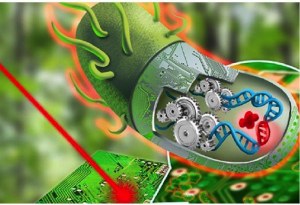By Yitong Li
The recent E. coli outbreak is all over the news these days. These malignant bacteria can be found in romaine lettuce, leafy vegetables, and possibly all salad mixes. Many people have been hospitalized because of it and one person has died. According to the Centers for Disease Control and Prevention, this is the worst E. coli outbreak since 2006. The culprit for this outbreak, the single cell E. coli bacteria, produces a toxin called Shiga that damages organs and leads to severe kidney failure. This all sounds very horrific. Based on the news, E. coli is such a dangerous bug and it makes sense that we should all avoid it as much as possible.
However, just like there are many different breeds of dogs, over 45 different strains of Escherichia coli (or simply E. coli) have been identified by microbiologists. Only a handful of the strains are harmful to humans, such as the Shiga-toxin-producing strain O157:H7 mentioned before. Most strains of E. coli turn out to be neutral or even beneficial to us. The good E. coli that inhabit our intestines have developed an intimate and symbiotic relationship with us throughout evolution. Like most other microorganisms that reside in our guts, E. coli help breakdown the complex sugars we eat and provide nutrients like vitamin K and B12. An interesting characteristic of E. coli is that they are genetically promiscuous, meaning that they can easily exchange genes between strains and even with other bacteria. This special ability is what inducted E. coli into the Hall of Fame for both pathogens responsible for grotesque outbreaks and important contributors to biotechnology.
By obtaining genes that enable toxin production or host invasion, E. coli can become pathogenic and dangerous to humans. An example of this is the E. coli outbreak in Germany in 2011. The strain responsible for this outbreak, O104:H4, was originally less harmful. Its efficient host invasion mechanism can cause diarrhea, but it is not very severe. However, after incorporating the genetic factor for Shiga toxin production, this strain became the vicious bug that led to almost 4000 disease cases and 53 deaths. It’s the genetic combination of toxin production and effective host invasion that created this dreadful devil.
Every coin has two sides. The genetic malleability of E. coli has also made them a very useful tool for scientists. To study the function of certain genes, scientists use E. coli to synthesize different variants of genes of all origins. By hijacking the gene expression machinery of E. coli, biologists can harvest a lot of DNA from the bacterial cells. These DNA can then be introduced to cells or even animals where they are normally found (e.g. mammalian cells) for functional studies. The final products of these genes, proteins, can also be isolated from E. coli for research that analyzes protein structures and functions. Special lab strains of E. coli, such as DH5, were engineered to take up foreign DNA more effectively, which again is possible thanks to the genetic malleability of these bugs. Aside from E. coli’s genetic promiscuity, their genetic simplicity and rapid growth rate further consolidate their status as one of scientists’ favorite tools. In 1997, E. coli became the first organism whose complete genome was sequenced and assembled. Compared to the sophisticated human genome that hosts over 30,000 genes, E. coli only contains 4400, all of which are well understood. In contrast to mammalian cells that divide every 10 to 12 hours, the 20-minute duplication time of E. coli ensures rapid production of large quantities of biological molecules, significantly driving down the costs of scientific research. Because of all these advantages, E. coli have become a model organism for a lot of biological studies and have contributed to 11 Nobel Prize winning discoveries since 1958. Even today, E. coli are still the go-to bugs for DNA cloning.

If you think we are only using E. coli as our servants to mass produce biological molecules of interest, you will be surprised to see how much more scientists have exploited the simplicity of this organism. A research group at Stanford University has been working on the concept of biological computer for years and successfully proved the feasibility of this wild idea using E. coli. A biological computer is a cell engineered to perform basic functions of a computer: logic, data storage, and data transmission. Dr. Drew Endy and his team were able to achieve this goal by genetically engineering the gene expression pathways in E. coli. They inserted additional genes into the E. coli genome to consistently create a gene expression output in response to a specific input. In this sense, the E. coli gene expression pathway can be used as a logic circuit where input-output correlation is established and accurately controlled. Theoretically, this technique can help us achieve finer control over cells in various aspects such as disease diagnosis and treatment, drug delivery, and vital sign monitoring. It might also pave the way for a future where artificial intelligence and humanity merge into a new semi-natural-semi-synthetic entity, as cells can function like computers.
Hey, but don’t forget, it all started with this 2-µm long single cell bacteria that we love and hate.
Edited by Sam Stadmiller and Mike Pablo

